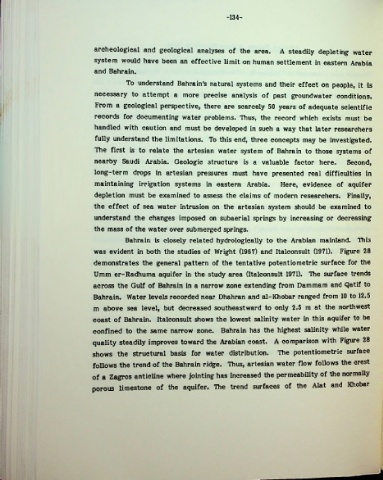Page 158 - Life & Land Use on the Bahrain Islands (Curtis E Larsen)
P. 158
-134-
archeological and geological analyses of the area. A steadily depleting water
system would have been an effective limit on human settlement in eastern Arabia
and Bahrain.
To understand Bahrain's natural systems and their effect on people, it is
necessary to attempt a more precise analysis of past groundwater conditions.
From a geological perspective, there are scarcely 50 years of adequate scientific
records for documenting water problems. Thus, the record which exists must be
handled with caution and must be developed in such a way that later researchers
fully understand the limitations. To this end, three concepts may be investigated.
The first is to relate the artesian water system of Bahrain to those systems of
nearby Saudi Arabia. Geologic structure is a valuable factor here. Second,
long-term drops in artesian pressures must have presented real difficulties in
maintaining irrigation systems in eastern Arabia. Here, evidence of aquifer
depletion must be examined to assess the claims of modern researchers. Finally,
the effect of sea water intrusion on the artesian system should be examined to
understand the changes imposed on subaerial springs by increasing or decreasing
the mass of the water over submerged springs.
Bahrain is closely related hydrologically to the Arabian mainland. This
was evident in both the studies of Wright (1967) and Italconsult (1971). Figure 28
demonstrates the general pattern of the tentative potentiometric surface for the
Umm er-Radhuma aquifer in the study area (Italconsult 1971). The surface trends
across the Gulf of Bahrain in a narrow zone extending from Dammam and Qatif to
Bahrain. Water levels recorded near Dhahran and al-Khobar ranged from 10 to 12.5
m above sea level, but decreased southeastward to only 2.5 m at the northwest
coast of Bahrain. Italconsult shows the lowest salinity water in this aquifer to be
confined to the same narrow zone. Bahrain has the highest salinity while water
quality steadily improves toward the Arabian coast. A comparison with Figure 28
shows the structural basis for water distribution. The potentiometric surface
follows the trend of the Bahrain ridge. Thus, artesian water flow follows the crest
of a Zagros anticline where jointing has increased the permeability of the normally
porous limestone of the aquifer. The trend surfaces of the Alat and Khobar

